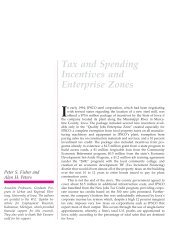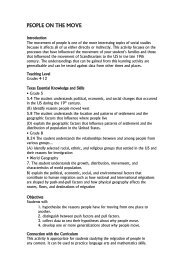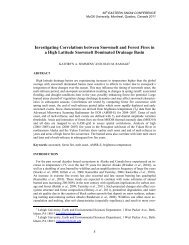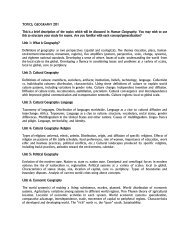Texas Social Studies Framework - Department of Geography ...
Texas Social Studies Framework - Department of Geography ...
Texas Social Studies Framework - Department of Geography ...
You also want an ePaper? Increase the reach of your titles
YUMPU automatically turns print PDFs into web optimized ePapers that Google loves.
50<br />
50<br />
Inquiry Teaching<br />
Inquiry teaching is a process <strong>of</strong> asking and answering<br />
key social studies questions. (See Teaching Generalizations,<br />
Inductive Approach). It is the scientific method<br />
applied to social studies and in many cases mirrors the<br />
ways social scientists (economists, historians, geographers,<br />
political scientists) conduct research. Students do<br />
the following:<br />
• identify and clarify questions, issues, or problems;<br />
• propose a hypothesis;<br />
• collect and organize data and evidence related to<br />
the questions;<br />
• evaluate, interpret, and analyze the data; and<br />
• draw inferences or conclusions to answer the<br />
initial questions.<br />
In a variation <strong>of</strong> inquiry teaching, a topic such as the<br />
Civil War or the Great Depression is presented in the<br />
context <strong>of</strong> an inquiry question. Students research the<br />
question in order to learn about the topic. For example,<br />
as part <strong>of</strong> a study <strong>of</strong> the Great Depression, this inquiry<br />
question might be posed: What were the short and long<br />
term causes and effects <strong>of</strong> the Great Depression? In order<br />
to answer this open-ended question, students study<br />
history, economics, culture, government, geography, and<br />
science, technology and society in an integrated fashion.<br />
Problem Solving and Decision Making<br />
Each process involves a series <strong>of</strong> steps in which students<br />
use facts, concepts, and generalizations to reach a<br />
conclusion or solution. There are a number <strong>of</strong> approaches<br />
to problem solving. Figure 24 illustrates a systematic<br />
approach to problem solving and decision making.<br />
Visual Strategies<br />
Most students learn through both hearing and seeing.<br />
Presenting new material using visuals such as pictures,<br />
slides, overhead transparencies, maps, demonstrations,<br />
and objects is a good teaching strategy. This is especially<br />
true if students are involved and interactivity is built into<br />
the presentation. Students need to develop their skills <strong>of</strong><br />
observation and visual analysis. Another powerful<br />
instructional strategy is for students to construct and<br />
prepare their own visual presentations. PowerPoint,<br />
Hyperstudio, Inspiration, KidPix, and other s<strong>of</strong>tware<br />
<strong>of</strong>fer students exciting venues for their creativity and<br />
opportunities to demonstrate what they have learned.<br />
Chapter 5: The Teaching-Learning System: Curriculum, Instruction, and Assessment<br />
Students choose the images; develop the story and<br />
narration based on interpretation <strong>of</strong> events, data, and<br />
information; and make a presentation or produce a visual<br />
product.<br />
Community-Based Instruction<br />
Community-based instruction is a new name for an old<br />
idea, namely, using real life situations and settings to<br />
enrich classroom instruction. Traditionally, such techniques<br />
have included community volunteer work,<br />
switching positions with town <strong>of</strong>ficials for a day, observing<br />
court cases, and doing field work. Community-based<br />
instruction should have clear educational goals, high<br />
expectations for student performance, and be well<br />
integrated with the TEKS and other curriculum to be<br />
successful. In service learning, a type <strong>of</strong> communitybased<br />
instruction, students have the opportunity to serve<br />
the community and to learn and apply significant life and<br />
social studies skills.<br />
Role Play and Simulations<br />
Students love playing roles. They enjoy assuming a<br />
different identity. In the process, they learn valuable<br />
social skills such as developing empathy and seeing<br />
situations from multiple perspectives. Simulations, or<br />
reenactments <strong>of</strong> events, are also effective at helping<br />
students engage in problem solving in real world<br />
contexts. Simulations and role plays are wonderful ways<br />
to make events from the past or present come alive.<br />
Role playing takes place in five stages:<br />
• Initiation and Direction: The teacher identifies a<br />
topic. Good topics require students to look at<br />
many sides <strong>of</strong> an issue, develop an opinion, and<br />
play interesting people.<br />
• Describing the Context: The teacher sets the<br />
context and makes sure students do not fall into<br />
the trap <strong>of</strong> presentism (role playing with hindsight).<br />
• Roles. Every student must have a role, even if<br />
that <strong>of</strong> “juror,” “interested citizen,” or “newspaper<br />
reporter.” Once assigned, time is needed for<br />
students to understand their roles, to practice,<br />
and try on their new identities.<br />
• Enactment: This is the time when the students<br />
actually play the roles. They do not recreate an<br />
event.
















